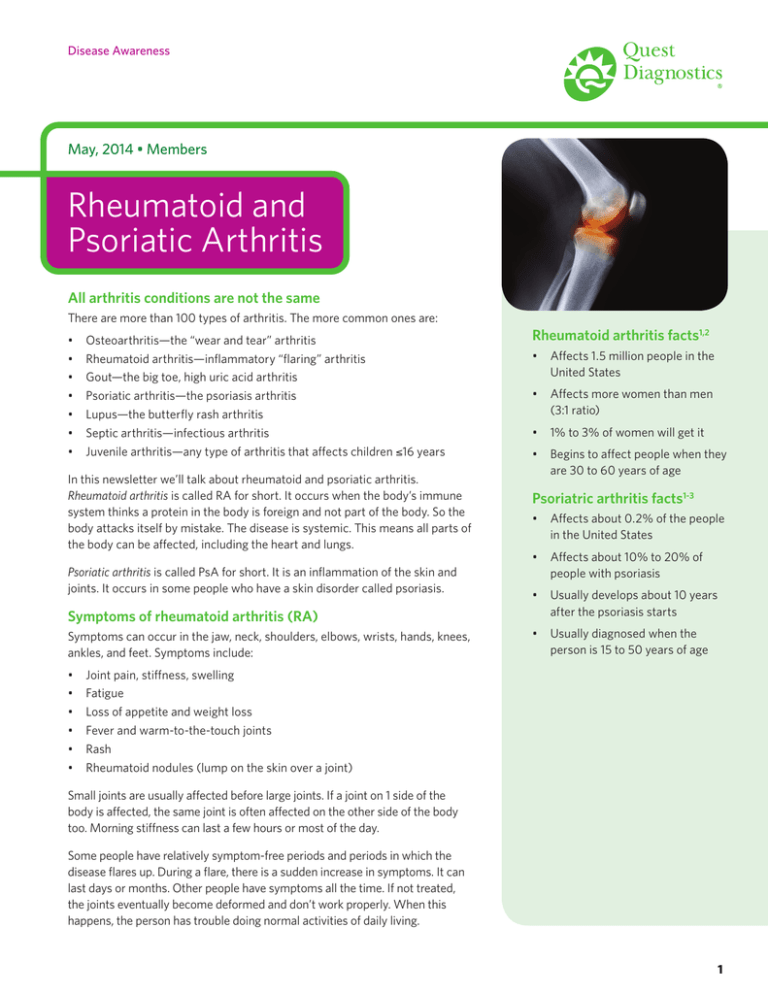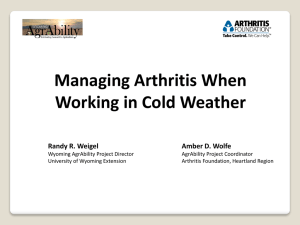
Disease Awareness
May, 2014 • Members
Rheumatoid and
Psoriatic Arthritis
All arthritis conditions are not the same
There are more than 100 types of arthritis. The more common ones are:
•
•
•
•
•
•
•
steoarthritis—the “wear and tear” arthritis
O
Rheumatoid arthritis—inflammatory “flaring” arthritis
Gout—the big toe, high uric acid arthritis
Psoriatic arthritis—the psoriasis arthritis
Lupus—the butterfly rash arthritis
Septic arthritis—infectious arthritis
Juvenile arthritis—any type of arthritis that affects children ≤16 years
In this newsletter we’ll talk about rheumatoid and psoriatic arthritis.
Rheumatoid arthritis is called RA for short. It occurs when the body’s immune
system thinks a protein in the body is foreign and not part of the body. So the
body attacks itself by mistake. The disease is systemic. This means all parts of
the body can be affected, including the heart and lungs.
Psoriatic arthritis is called PsA for short. It is an inflammation of the skin and
joints. It occurs in some people who have a skin disorder called psoriasis.
Symptoms of rheumatoid arthritis (RA)
Symptoms can occur in the jaw, neck, shoulders, elbows, wrists, hands, knees,
ankles, and feet. Symptoms include:
•
•
•
•
•
•
Rheumatoid arthritis facts1,2
• A
ffects 1.5 million people in the
United States
• A
ffects more women than men
(3:1 ratio)
• 1% to 3% of women will get it
• B
egins to affect people when they
are 30 to 60 years of age
Psoriatric arthritis facts1-3
• A
ffects about 0.2% of the people
in the United States
• A
ffects about 10% to 20% of
people with psoriasis
• U
sually develops about 10 years
after the psoriasis starts
• U
sually diagnosed when the
person is 15 to 50 years of age
Joint pain, stiffness, swelling
Fatigue
Loss of appetite and weight loss
Fever and warm-to-the-touch joints
Rash
Rheumatoid nodules (lump on the skin over a joint)
Small joints are usually affected before large joints. If a joint on 1 side of the
body is affected, the same joint is often affected on the other side of the body
too. Morning stiffness can last a few hours or most of the day.
Some people have relatively symptom-free periods and periods in which the
disease flares up. During a flare, there is a sudden increase in symptoms. It can
last days or months. Other people have symptoms all the time. If not treated,
the joints eventually become deformed and don’t work properly. When this
happens, the person has trouble doing normal activities of daily living.
1
Rheumatoid and Psoriatic Arthritis
Members
Symptoms related to psoriatic arthritis (PsA)
Are you at risk?
About 10% to 20% of people with psoriasis develop PsA. These people
may have:
Risk factors for RA include:
• Patchy, scaly, red or white areas of skin
• Bacterial or viral infection
• Pitted or discolored fingernails
• Smoking
• Nails that separate from the nail bed
• S
ex—women are 3 times as likely
to get it than men
3
• Swelling of fingers and toes
• Stiffness
• Painful joints or back pain
• Family history
• A
ge—diagnosis is more common
in people 40 to 60 years old
• T
enderness, pain, or swelling over the tendons that connect muscle
to bone
Risk factors for PsA include:
• Fatigue
• Family history of psoriasis
• Anemia
• A
ge—diagnosis is more common
in people between 30 and 50
years old
Often only 1 or a few joints are affected. It could be a finger, toe, spine, or
knee. In most people, skin symptoms show up years before joint symptoms.
But in others, joint damage can occur early on.
• Being diagnosed with psoriasis
Diagnosis and treatment
There is no cure for these types of arthritis, but treatment can help.
Treatment is not the same for all types of arthritis, even though some
of the symptoms are the same. So it’s important to get diagnosed and
find out which type of arthritis it is. Then the right treatment can be
selected. Treatment can include medication, a healthy diet, weight
control, and exercise.
Early diagnosis and treatment are critical. This is because joint damage
cannot be reversed, and treatment can slow or halt the progression. If
inflammation is kept low, then the joints might not get deformed as quickly.
This means the joints will continue to work the way they should for a longer
period of time. The patient will be able to live an active, more normal life.
2
Rheumatoid and Psoriatic Arthritis
Members
Laboratory testing for arthritis
References
There is no one test that can be used to diagnose arthritis or find out which
type it is. But there are tests that can help. Rheumatoid factor (RF) and
anti-CCP are standard tests for RA. A new test called 14-3-3 eta looks like
it will be helpful too. So far, it looks like more people who have RA can be
diagnosed when these 3 tests are used together.4
1.
RF:
• Generally 60% to 90% of people with RA test positive.
• Fewer people test positive in early stages of RA.
• R
F positivity in early RA means the patient is likely to have more
severe RA.
• H
igher amounts of RF mean the patient is likely to have more
severe RA.
• P
eople with other autoimmune diseases, certain infections, or cancer
can also have RF.
Anti-CCP
• 55% to 85% of people with RA test positive.
5-7
• Almost all people who test positive have RA.
• A positive result in early RA predicts more severe RA in 3 to 10 years.
14-3-3 eta
• 60% to 82% of people with RA test positive.4
• I t does not appear to be positive in people with related conditions
(except PsA).
rthritis Foundation. Learn about arthritis
A
http://www.arthritis.org/conditionstreatments/. Accessed March 19, 2014.
2. W
ebMD® Rheumatoid Arthritis Health
Center. webmd.com/rheumatoid-arthritis/
guide/default.htm. Accessed March 19,
2014.
3. M
ease P. Update on treatment of psoriatic
arthritis. Bull NYU Hosp Jt Dis. 2012;70:167171.
4. M
arotta A, Bykerk V, Siminovitch KA, et al.
Extracellular 14-3-3: an early rheumatoid
arthritis pathogenic factor. [abstract].
Arthritis Rheum. 2011;63(suppl 10):378.
5. B
izzaro N, Mazzanti G, Tonutti E, et al.
Diagnostic accuracy of the anti-citrulline
antibody assay for rheumatoid arthritis.
Clin Chem. 2001;47:1089-1093. Erratum in:
Clin Chem. 2001;47:1748.
6. S
auerland U, Becker H, Seidel M, et al.
Clinical utility of the anti-CCP assay:
experiences with 700 patients. Ann N Y
Acad Sci. 2005;1050:314-318.
7. L ee DM, Schur PH. Clinical utility of the
anti-CCP assay in patients with rheumatic
diseases. Ann Rheum Dis. 2003;62:870874.
8. M
edicineNet.com Psoriatic arthritis. http://
www.medicinenet.com/psoriatic_arthritis/
page2.htm. Accessed March 19, 2014.
• The level is higher in RA and PsA patients who have joint damage.
Doctors sometimes use the HLA-B27 test to help diagnose psoriatic
arthritis. Over 50% of those with an inflamed spine are positive.8
There are 2 tests that can be used to measure the amount of inflammation.
They are called the ESR (erythrocyte sedimentation rate) test and the CRP
(C-reactive protein) test. Doctors use these tests to see how a patient is
doing on the therapy.
QuestDiagnostics.com
Quest, Quest Diagnostics, any associated logos, and all associated Quest Diagnostics registered or unregistered trademarks are the property of Quest Diagnostics.
All third party marks - ® and ™ - are the property of their respective owners. © 2014 Quest Diagnostics Incorporated. All rights reserved. 05/2014
3







